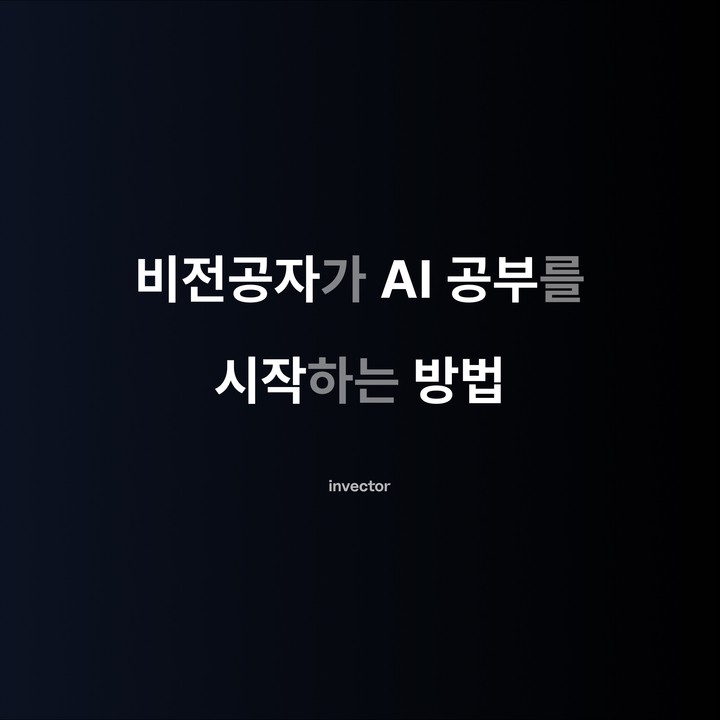Insight
Studying AI: Starting from defining tasks for practical application.
Dec 22, 2024

How Non-Specialists Can Start Learning AI: Begin with Defining Practical Work Applications
Introduction: The Rise of AI and the Challenges for Non-Specialists
In recent years, AI has revolutionized industries worldwide, from customer data analysis and production automation to personalized recommendation systems. While it offers transformative opportunities, it also brings anxiety. Many wonder, "Will AI replace my job?" or "Is my industry fundamentally changing because of AI?" This FOMO (Fear of Missing Out) has driven individuals and businesses to consider how they can adapt to this rapidly evolving landscape.
For non-specialists, starting to learn AI can feel particularly daunting. Questions like, "Can I really learn AI without strong programming or math skills?" or "Will this knowledge be relevant to my work?" often create a significant mental barrier.
This guide aims to address these concerns by outlining how non-specialists can approach learning AI effectively and in a way that directly benefits their practical work needs.
Why AI Feels Difficult for Non-Specialists: The Challenge of Abstraction
The main hurdle in learning AI for non-specialists lies in understanding the appropriate level of abstraction. Abstraction, in simple terms, means focusing on what’s necessary to achieve your goals while ignoring unnecessary complexities.
For instance, think about learning to drive. To become a good driver, you don’t need to study the history of automobiles, the mechanics of gear systems, or the physics behind ABS braking. Instead, mastering acceleration, braking, steering, and traffic rules is sufficient. Overthinking mechanical principles would distract you from developing actual driving skills.Similarly, learning AI doesn’t require a deep dive into mathematical theories or programming intricacies for most non-specialist applications. Instead, understanding key concepts in machine learning and deep learning—and how they can solve your specific problems—is far more valuable.
For example, non-specialists don’t need to independently learn Python or linear algebra. Instead, they should focus on understanding basic AI concepts and how these can be applied to their work. The key is to learn what you need, not everything.
First Steps in AI Learning: Start by Defining Work Applications
Ironically, the first step to learning AI isn’t studying AI itself—it’s identifying where AI can be applied in your work. To do this, start by breaking your tasks into rule-based and judgment-based activities. Rule-Based Tasks: Can be solved using predefined rules or procedures.
Judgment-Based Tasks: Require human reasoning and contextual decision-making.Distinguishing between these types of tasks is harder than it seems, but it’s essential for determining which areas AI can optimize.
Ask yourself the following questions:
Can this problem be solved using explicit rules written by a person?
How often do these rules change, and are there exceptions?
Which parts of the problem require human judgment or decision-making?
For example, let’s say your job involves consolidating data from five spreadsheets into one. Define the problem with these questions:
Rule-Based: Is the consolidation process based on fixed rules (e.g., copying cells from a specific range)?
Exceptions: Are all five spreadsheets formatted the same way, or do exceptions exist? (e.g., Will there be 10 spreadsheets next year?)
Judgment-Based: Do I need to make decisions during the process (e.g., excluding specific cells, selecting higher values, adjusting inconsistent formats)?
By defining tasks this way, you can identify which problems AI is best suited to solve—typically judgment-based tasks that involve automation and prediction.
Why Task Analysis Matters for AI Adoption
Task analysis naturally highlights the potential areas for AI application. Understanding your workflows helps you identify repetitive, time-consuming tasks and determine how AI might streamline them.
For non-specialists, the key is to focus on practical applications:
Find repetitive tasks: These are usually the easiest to automate with AI tools.
Pinpoint data-heavy processes: AI thrives in areas involving large datasets, such as analytics, reporting, and predictions.
Address judgment gaps: AI can enhance decision-making by analyzing patterns or providing insights that humans might overlook.
For example, if your job involves managing invoices, you might identify areas where AI could help:
Automating invoice classification.
Predicting payment delays.
Extracting key information using OCR (Optical Character Recognition).
Practical AI Learning for Non-Specialists
Here’s a step-by-step approach for non-specialists to begin learning AI effectively:
Understand Basic Concepts
Focus on high-level overviews of machine learning, deep learning, and their real-world applications.
Resources: Free platforms like Coursera (AI for Everyone by Andrew Ng) or introductory AI explainer videos on YouTube.
Explore No-Code AI Tools
Experiment with user-friendly platforms like Microsoft Power Automate, DataRobot, or Lobe. These tools allow you to implement AI solutions without requiring programming knowledge.
Analyze Your Workflow
Use the task definition framework discussed earlier to identify repetitive or judgment-based tasks.
Create a list of potential applications for AI in your daily work.
Leverage AI-Powered Applications
Experiment with existing tools specific to your industry (e.g., OCR software for document automation or analytics platforms for data insights).
Learn by Doing
Start small: Apply AI to automate a single repetitive task or generate a simple report.
Iteratively refine your approach as you gain familiarity with the tools and concepts.
Conclusion
AI learning feels daunting because it’s hard to gauge the right level of abstraction for non-specialists. However, the goal for non-specialists isn’t to master AI’s inner workings but to leverage it for productivity and problem-solving.
By analyzing workflows and defining tasks that AI can tackle, you can make informed decisions about where to focus your learning efforts. This practical, application-first approach ensures that AI becomes a tool to enhance your efficiency rather than an overwhelming academic pursuit.In our next post, we’ll explore specific examples of tasks AI can automate and how you can implement these solutions effectively. Stay tuned to discover how AI can transform your work, one task at a time!